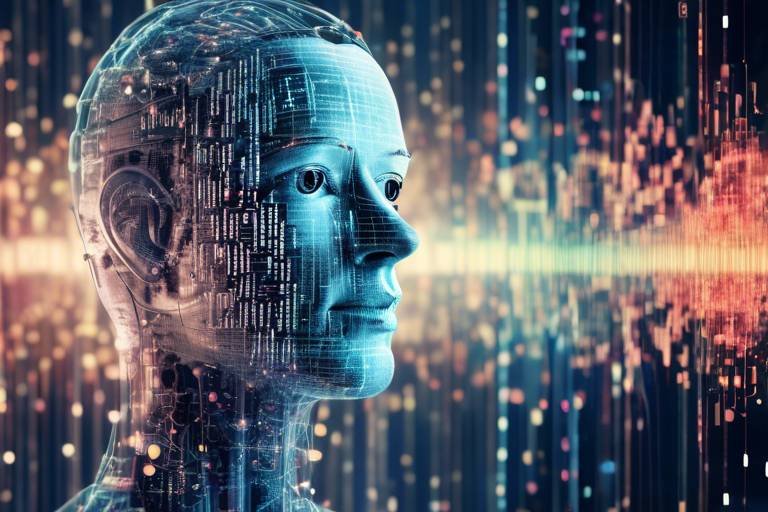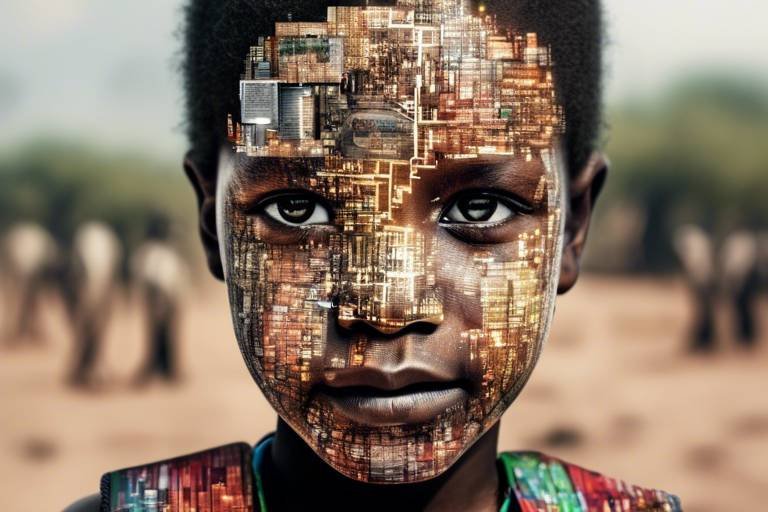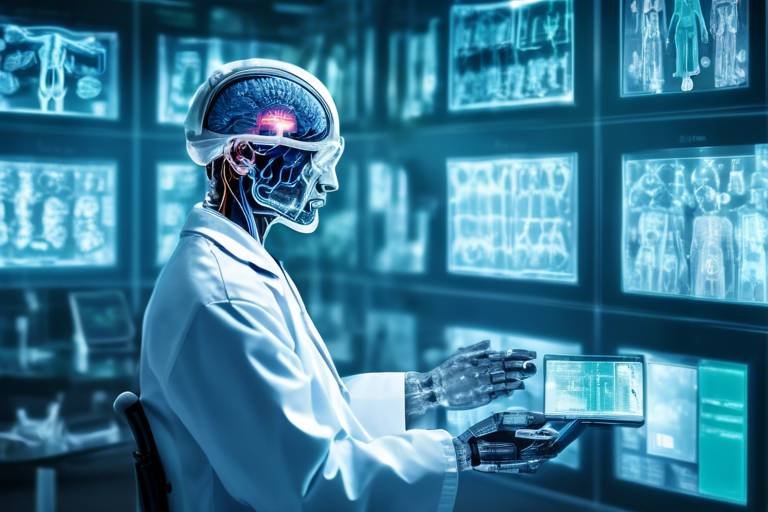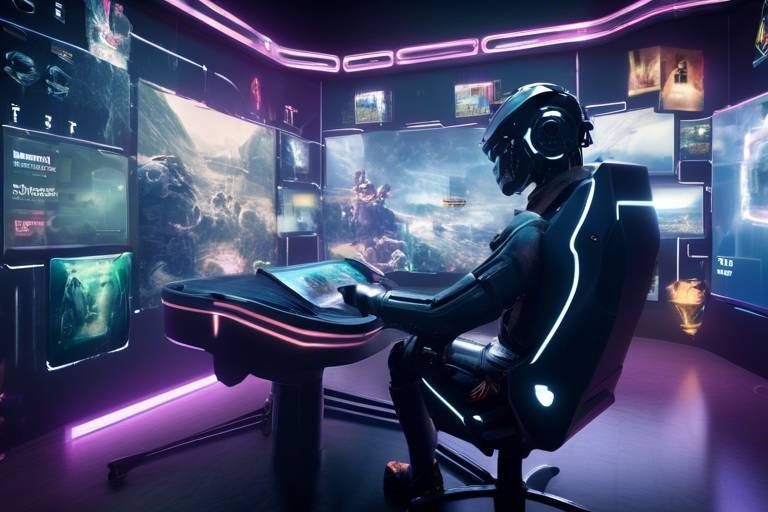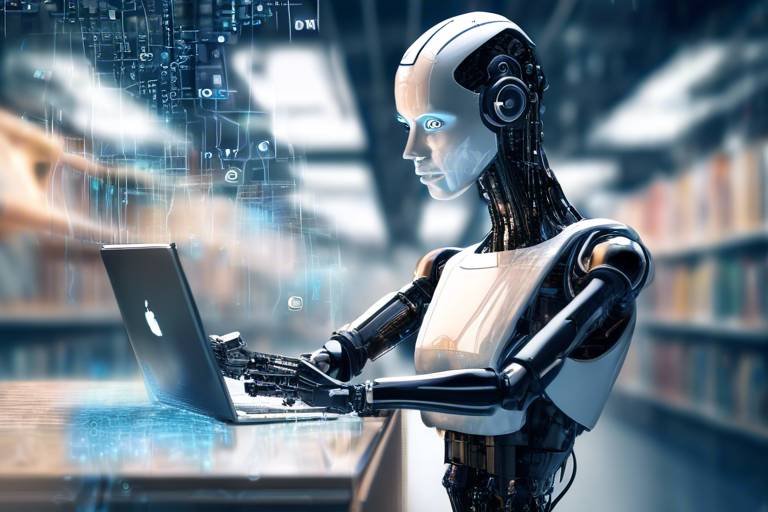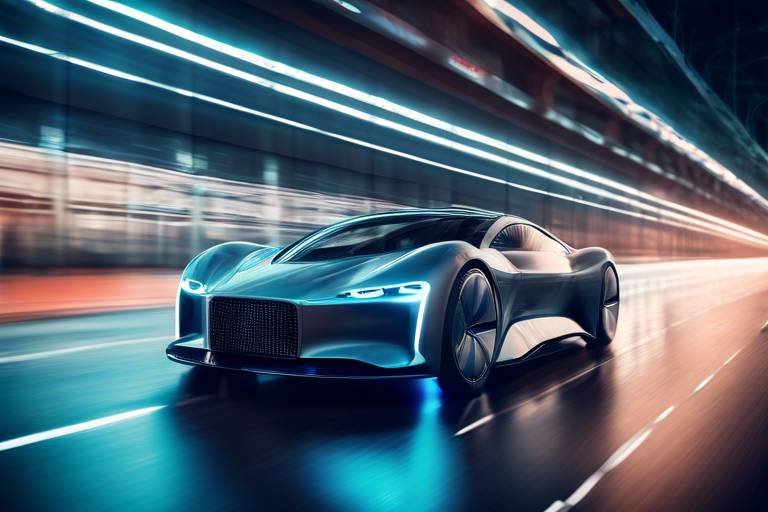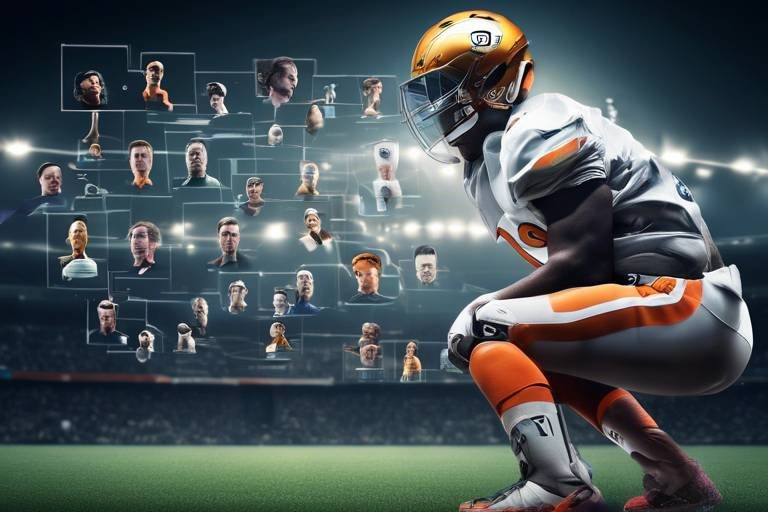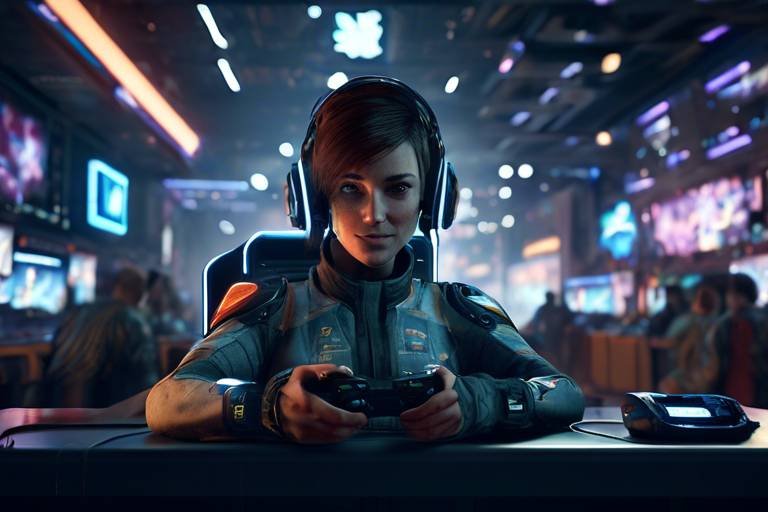AI in Hollywood: Role of Machine Learning in Entertainment
In recent years, the entertainment industry has witnessed a seismic shift thanks to the advent of artificial intelligence (AI) and machine learning. These technologies are not just buzzwords; they are actively reshaping how stories are told, how films are made, and how audiences engage with content. Imagine a world where scripts are crafted with the help of algorithms that analyze audience preferences, or where casting decisions are made based on data-driven insights rather than gut feelings. This is not science fiction; this is the new reality of Hollywood.
As we delve deeper into the transformative impact of AI and machine learning, we can see a pattern emerging. These technologies are enhancing creativity, streamlining production processes, and personalizing viewer experiences like never before. The implications are vast, reaching from the earliest stages of scriptwriting to the final touches of visual effects. The integration of AI is not merely a trend; it's a fundamental shift that promises to redefine the entertainment landscape.
One of the most exciting aspects of AI's role in Hollywood is its ability to analyze vast amounts of data. For instance, machine learning algorithms can sift through countless scripts, identifying successful elements that resonate with audiences. This data-driven approach helps writers craft engaging narratives that are tailored to viewer preferences. It’s akin to having a personal assistant who knows exactly what the audience wants, allowing creators to focus on their craft while AI handles the analytics.
Moreover, AI is not just a tool for writers; it’s revolutionizing casting decisions as well. By analyzing data from actors' past performances, social media presence, and audience appeal, AI can recommend the best-fit actors for specific roles. This means producers can make more informed choices, ultimately enhancing the chances of a film's success. But it doesn’t stop there—AI is also paving the way for greater diversity in casting by identifying a broader range of actors, thus fostering inclusivity in the film industry.
However, with great power comes great responsibility. The reliance on AI for casting decisions raises ethical dilemmas and potential biases that must be addressed. Are we reinforcing stereotypes by allowing algorithms to dictate who gets cast? These questions are critical as we navigate the complexities of AI in entertainment.
As we move forward, it’s essential to consider how machine learning is enhancing audience engagement. Streaming platforms are utilizing algorithms to analyze viewer preferences, creating personalized content recommendations that enhance user experience. This means that viewers are more likely to find content that resonates with them, keeping them engaged and satisfied. The days of one-size-fits-all programming are fading, replaced by a more tailored approach that speaks directly to individual tastes.
In the realm of visual effects, AI technologies are streamlining the creation process, allowing for more realistic imagery while reducing production time and costs. Automated animation techniques are enabling artists to focus on their creativity rather than getting bogged down in repetitive tasks. Imagine a world where animators can bring their wildest visions to life without the constraints of time-consuming processes. That’s the promise of AI in animation.
Furthermore, machine learning enhances CGI by allowing for real-time adjustments based on audience feedback. This capability creates more immersive viewing experiences, making it possible for filmmakers to adapt scenes on-the-fly to better suit audience reactions. It’s a game-changer, transforming the way stories are told and experienced.
As we look to the future, the potential for AI in Hollywood is limitless. Emerging technologies will likely continue to revolutionize the entertainment landscape, pushing the boundaries of creativity and innovation. The question is, how far will we go? Only time will tell, but one thing is certain: AI is here to stay, and its impact on the entertainment industry will only grow.
- How is AI used in scriptwriting? AI analyzes existing scripts and audience preferences to help writers create engaging narratives.
- Can AI help with casting decisions? Yes, AI evaluates actors' past performances and audience appeal to recommend suitable candidates for roles.
- What are the ethical concerns surrounding AI in casting? There are concerns about potential biases and the reinforcement of stereotypes through AI-driven decisions.
- How does AI enhance audience engagement? AI analyzes viewer preferences to provide personalized content recommendations on streaming platforms.
- What future trends can we expect from AI in entertainment? Emerging technologies will likely continue to enhance creativity and innovation in storytelling and production.

Machine Learning in Scriptwriting
In the fast-paced world of Hollywood, machine learning is becoming a game-changer for scriptwriters. Imagine a world where algorithms can help craft the next blockbuster script, analyzing the nuances of storytelling and character development. With the power of data analysis, these algorithms sift through countless scripts, identifying patterns and trends that can lead to more engaging narratives. This isn't just a futuristic dream—it's happening right now!
By leveraging large datasets, machine learning tools can assist writers in optimizing dialogue, ensuring that every line resonates with the audience. For instance, algorithms can evaluate the emotional weight of certain phrases, suggesting alternatives that might evoke a stronger reaction. This means that writers are not just relying on their instincts; they have a digital partner that provides insights grounded in real audience reactions.
But how does this actually work? Think of it like this: if a writer is crafting a romantic comedy, machine learning algorithms can analyze previous successful scripts in the genre, identifying key elements that made them hit films. These elements might include:
- Character archetypes that resonate well with audiences
- Common plot twists that keep viewers engaged
- Dialogue styles that evoke laughter or tears
Moreover, machine learning can predict audience reactions based on demographic data and viewing habits. Imagine being able to tailor a script to different audience segments, enhancing the chances of its success at the box office. This level of personalization is revolutionary, allowing writers to craft stories that not only entertain but also connect deeply with viewers.
However, while machine learning offers exciting possibilities, it also raises questions about creativity and originality. Are we risking the authenticity of storytelling by relying too heavily on algorithms? Writers must find a balance between utilizing these tools and maintaining their unique voice. After all, the heart of storytelling lies in the human experience, something that a machine can analyze but never truly replicate.
In conclusion, machine learning is transforming scriptwriting by providing writers with invaluable insights and data-driven recommendations. This technology is not a replacement for creativity but rather a powerful ally that can help storytellers craft narratives that captivate audiences. As we move forward, it will be fascinating to see how this dynamic relationship evolves, potentially leading to a new era of storytelling that blends technology with the timeless art of narrative.
Q1: How does machine learning improve scriptwriting?
A1: Machine learning analyzes existing scripts to identify successful patterns, helping writers craft more engaging narratives and optimize dialogue.
Q2: Can machine learning replace human writers?
A2: No, while machine learning can assist in the writing process, it cannot replicate the creativity and emotional depth that human writers bring to storytelling.
Q3: What are the ethical considerations of using AI in scriptwriting?
A3: Writers must ensure that reliance on machine learning does not compromise originality and creativity, maintaining a balance between technology and human insight.

AI-Driven Casting Decisions
In the ever-evolving landscape of Hollywood, are becoming a game changer. Imagine a world where casting directors no longer rely solely on gut feelings or traditional methods to find the perfect actor for a role. Instead, they’re harnessing the power of artificial intelligence to sift through mountains of data, making the casting process not just more efficient but also more effective. This shift is comparable to having a personal assistant who not only remembers every detail but also suggests the best options based on past experiences and current trends.
AI systems analyze a treasure trove of information, including actors' past performances, their social media presence, and even audience reactions to their previous roles. By crunching these numbers, AI can recommend actors who not only fit the character profile but also have a proven track record of engaging audiences. This data-driven approach reduces the guesswork that often plagues casting decisions, ensuring that producers are more likely to select actors who will resonate with viewers.
One of the fascinating aspects of this AI-driven approach is its potential to enhance diversity in casting. Traditionally, casting decisions have often favored a narrow range of actors, sometimes perpetuating stereotypes. However, with AI, producers can access a wider pool of talent. For instance, algorithms can identify lesser-known actors who may not have received the same level of exposure yet possess the talent and charisma needed for the role. This approach not only fosters inclusivity but also enriches storytelling by bringing fresh perspectives to the screen.
However, the integration of AI into casting isn't without its challenges. While the technology offers numerous advantages, it raises ethical questions regarding bias. If the data fed into these AI systems contains historical biases, there’s a risk that the AI could inadvertently reinforce stereotypes or overlook equally talented actors from underrepresented backgrounds. It’s crucial for industry professionals to remain vigilant and ensure that AI tools are used responsibly, taking steps to mitigate any potential biases that could influence casting decisions.
In summary, the role of AI in casting decisions presents a fascinating blend of opportunity and responsibility. As Hollywood continues to embrace these technologies, the focus must remain on using AI to enhance creativity and inclusivity, rather than allowing it to dictate the narrative. The future of casting could very well be a harmonious collaboration between human intuition and machine learning, leading to more engaging and diverse storytelling.
- How does AI improve the casting process? AI analyzes vast amounts of data to recommend actors based on past performances, audience appeal, and social media presence, streamlining the casting process.
- Can AI promote diversity in casting? Yes, AI can identify a broader range of actors, encouraging inclusivity and providing opportunities for lesser-known talent.
- What are the ethical concerns surrounding AI in casting? Relying on AI can lead to biases if the underlying data is flawed, potentially reinforcing stereotypes or excluding qualified actors.

Data-Driven Actor Selection
In the ever-evolving landscape of Hollywood, has emerged as a game-changer, reshaping how casting decisions are made. Imagine a world where producers can sift through mountains of information to pinpoint the perfect actor for a role, all thanks to the power of artificial intelligence. This isn't science fiction; it's happening right now! By analyzing a plethora of data points, AI tools can evaluate an actor's past performances, social media presence, and even their audience appeal to recommend ideal candidates for specific roles.
Think of it like a matchmaking service, but instead of finding love, it's about pairing actors with the right characters. These algorithms dive deep into historical data, examining factors such as box office success, critical acclaim, and audience feedback. This comprehensive analysis allows filmmakers to make informed choices, significantly enhancing the chances of a film's success. For instance, AI can analyze how an actor's previous roles resonated with audiences, providing insights into their potential fit for new characters.
Moreover, the process isn't just about crunching numbers; it's about understanding the nuances of performance. AI tools can assess an actor’s emotional range, screen presence, and even their ability to connect with audiences on social media. This holistic approach ensures that casting decisions are not only data-driven but also resonate with the human experience, creating a more authentic connection between the audience and the characters they see on screen.
However, it's essential to recognize that while AI can significantly enhance the casting process, it is not without its challenges. The reliance on data can sometimes lead to an overemphasis on quantifiable metrics, potentially overshadowing the unique qualities that make an actor truly special. It's crucial for producers and directors to maintain a balance between data insights and their artistic instincts, ensuring that the magic of storytelling remains intact.
As we look to the future, the integration of AI in actor selection is likely to become even more sophisticated. With advancements in machine learning and data analytics, we can expect to see tools that not only recommend actors but also predict audience reactions to their performances. This could open up new avenues for storytelling and character development, allowing filmmakers to create more compelling narratives that resonate with diverse audiences.
In conclusion, data-driven actor selection represents a fascinating intersection of technology and creativity. By harnessing the power of AI, Hollywood is not just finding the right actors; it's redefining the very essence of storytelling itself. As we continue to explore this brave new world, one thing is clear: the future of casting is bright, and it's powered by data.
- How does AI analyze an actor's past performances? AI uses algorithms to evaluate box office data, critical reviews, and audience ratings to gauge an actor's effectiveness in previous roles.
- Can AI replace human casting directors? While AI can assist in the selection process, the human touch in understanding character nuances and emotional depth remains irreplaceable.
- What are the ethical implications of using AI in casting? There are concerns about bias and the potential reinforcement of stereotypes, making it crucial to use AI as a tool rather than a definitive decision-maker.
- How does audience feedback influence casting decisions? AI tools can analyze audience reactions from social media and reviews, providing insights into which actors might resonate best with viewers.

Impact on Diversity in Casting
In recent years, the conversation around diversity in Hollywood has gained significant momentum. With the advent of artificial intelligence in casting, there’s a unique opportunity to enhance inclusivity and representation within the film industry. AI tools have the potential to analyze a broader spectrum of talent, thereby identifying actors from various backgrounds who may have previously been overlooked. This shift is not just about filling quotas; it’s about enriching storytelling and bringing authenticity to characters.
Imagine a world where casting directors can tap into a diverse pool of talent at the click of a button. AI algorithms can sift through countless audition tapes, social media profiles, and past performance data to highlight actors who not only fit the physical description of a role but also bring unique cultural perspectives. This is crucial in a globalized society where audiences crave stories that reflect their own experiences and those of others.
Moreover, AI can help identify actors from underrepresented groups, breaking down the barriers that have historically limited opportunities for many talented individuals. By leveraging data-driven insights, producers can make more informed decisions that promote diversity, leading to richer narratives and a wider array of viewpoints. This not only benefits the actors but also enriches the audience's experience, offering them stories that resonate on a deeper level.
However, while the potential for increased diversity is promising, it’s essential to approach the integration of AI in casting with caution. There are ethical considerations to keep in mind. For instance, if AI systems are trained on biased datasets, they may inadvertently perpetuate stereotypes or exclude certain demographics. Therefore, it’s crucial for the industry to ensure that the data used to train these algorithms is representative and free from bias.
To illustrate the impact of AI on diversity in casting, consider the following table that outlines the potential benefits and challenges:
| Benefits | Challenges |
|---|---|
| Increased representation of diverse actors | Risk of reinforcing existing biases |
| Access to a broader talent pool | Potential lack of human intuition in decision-making |
| Enhanced storytelling through varied perspectives | Ethical dilemmas surrounding data usage |
In conclusion, while AI has the power to transform casting practices and promote diversity in Hollywood, it is essential to navigate this landscape thoughtfully. By combining the analytical capabilities of AI with the nuanced understanding of human experiences, the entertainment industry can move towards a future where every story is told by the voices that truly represent it.
- How does AI improve diversity in casting?
AI analyzes a wider range of talent, helping to identify actors from diverse backgrounds and ensuring more inclusive representation in films. - What are the potential risks of using AI in casting?
If not carefully managed, AI can reinforce existing biases and stereotypes, leading to ethical dilemmas in decision-making. - Can AI replace human casting directors?
While AI can provide valuable insights, the human touch is irreplaceable in understanding the nuances of performance and character. - What steps can the industry take to ensure ethical AI usage?
Ensuring diverse and unbiased datasets are used in training AI systems is crucial for ethical casting practices.

Challenges in AI Casting
The integration of AI in casting processes certainly brings a wave of innovation, but it also surfaces a myriad of challenges that the entertainment industry must navigate. One of the most pressing concerns is the potential for bias in the algorithms used to evaluate actors. These algorithms are designed to analyze vast amounts of data, including past performances and audience reactions. However, if the data fed into these systems is skewed or lacks diversity, the AI may inadvertently reinforce existing stereotypes or overlook talented actors who don’t fit conventional molds.
Moreover, the reliance on AI for casting decisions raises ethical questions. For instance, how do we ensure that the algorithms do not prioritize actors based solely on their social media following or marketability? While these factors are important, they shouldn't be the only criteria for selecting talent. The risk here is that the creative essence of storytelling could be compromised, leading to a homogenization of characters and narratives.
Another challenge lies in the transparency of AI decision-making processes. When producers rely on machine learning tools, it can often feel like a black box where the rationale behind actor selections is unclear. This lack of transparency can lead to mistrust among actors and industry professionals, who may question the fairness of the casting process. To address this, it is crucial for filmmakers to maintain a balance between AI-driven insights and human intuition. After all, storytelling is an art, and human creativity should not be overshadowed by algorithms.
Finally, the implementation of AI in casting could also lead to job displacement within the industry. As machines take on more roles in decision-making, there is a palpable concern among casting directors and agents about their relevance in the future. While AI can enhance efficiency, it is essential to remember that the human touch in casting—understanding nuances, emotions, and the chemistry between actors—is irreplaceable. Thus, the challenge lies in finding a harmonious coexistence between technology and human expertise.
In summary, while AI offers exciting possibilities for casting in Hollywood, it is essential to address these challenges head-on. By promoting diversity, ensuring transparency, and valuing human intuition, the industry can harness the power of AI without compromising its creative integrity.
- What are the main benefits of using AI in casting?
AI can analyze large datasets to identify actors who fit specific roles, potentially increasing the likelihood of a film's success. - How does AI impact diversity in casting?
AI has the potential to widen the pool of candidates by recognizing talent beyond traditional industry standards, but it can also reinforce biases if not carefully managed. - Can AI replace casting directors?
While AI can assist in the casting process, the nuanced understanding of human emotions and chemistry remains a critical aspect that only experienced casting directors can provide. - What ethical concerns are associated with AI in casting?
Ethical concerns include potential biases in algorithms, lack of transparency in decision-making, and the risk of job displacement for human casting professionals.

Audience Engagement and Personalization
In today's fast-paced world, capturing the audience's attention is more crucial than ever. Thanks to machine learning, the entertainment industry is experiencing a revolution in how content is tailored for viewers. Imagine walking into a cinema or logging onto a streaming platform, and the content presented to you feels like it was crafted just for you. This is not a distant dream but a reality made possible by sophisticated algorithms that analyze viewer behavior and preferences.
Machine learning algorithms sift through vast amounts of data, examining what audiences love and how they interact with different types of content. By analyzing past viewing habits, these algorithms can predict what a viewer is likely to enjoy next. For instance, if you've binge-watched a series filled with thrilling plot twists and strong female leads, the system might recommend similar shows or movies that align with those themes. This level of personalization not only keeps viewers engaged but also fosters a deeper connection between the audience and the content.
Moreover, the power of AI-driven recommendations extends beyond just suggesting what to watch next. It can also influence the way stories are told. By understanding audience preferences, creators can craft narratives that resonate more profoundly with their target demographic. For example, if data shows that a certain age group enjoys romantic comedies with a touch of drama, writers can tailor their scripts to include elements that appeal specifically to that audience.
But how does this all work? Here’s a simplified breakdown:
- Data Collection: Streaming platforms gather data from user interactions, including what shows are watched, how long they are viewed, and even what is skipped.
- Analysis: Machine learning algorithms analyze this data to identify patterns and preferences among different audience segments.
- Recommendations: Based on the analysis, personalized recommendations are generated, enhancing the viewer's experience.
Furthermore, audience engagement doesn't stop at recommendations. With the rise of interactive content, viewers are no longer passive consumers. They can influence the storyline, make choices, and even interact with characters. This level of engagement is not just a trend; it represents a fundamental shift in how stories are consumed. Think of it like being part of a choose-your-own-adventure book, where your decisions shape the narrative. This interactive approach not only keeps audiences hooked but also encourages them to return for more, knowing they have a say in the unfolding drama.
As we look to the future, the implications of AI in audience engagement are enormous. The more we learn about our viewers, the better we can create content that speaks directly to them. This not only benefits the audience but also the creators, as they can produce work that resonates, ultimately leading to greater success. The entertainment landscape is evolving, and with it comes the promise of a more personalized, engaging experience for every viewer.
| Question | Answer |
|---|---|
| How does AI personalize content recommendations? | AI analyzes user data, including viewing history and preferences, to suggest content that aligns with individual tastes. |
| Can AI influence the storytelling process? | Yes, by understanding audience preferences, AI can help writers craft narratives that resonate more with target demographics. |
| What is interactive content? | Interactive content allows viewers to make choices that influence the storyline, creating a more engaging viewing experience. |

AI in Visual Effects
When you think about blockbuster movies, what comes to mind? Thrilling action sequences, breathtaking landscapes, and fantastical creatures that seem almost real. Well, behind the curtain of these visual marvels lies a powerful ally: artificial intelligence. AI is revolutionizing the way visual effects (VFX) are created, transforming the industry into a realm of limitless possibilities. Imagine a world where the creation of stunning visuals is not only faster but also more cost-effective. That’s the magic AI brings to the table!
Traditionally, creating high-quality visual effects required a massive amount of time and effort from talented artists. However, with the advent of AI technologies, this process has become streamlined. AI algorithms can analyze vast amounts of data from previous films to identify patterns and techniques that work best. This means that artists can spend less time on repetitive tasks and focus more on unleashing their creativity. For instance, AI can automate tasks like rotoscoping, which involves tracing over footage to create realistic animations. By doing so, it not only speeds up production but also enhances the overall quality of the visuals.
One of the most exciting developments in AI for VFX is the ability to create real-time CGI enhancements. Imagine watching a movie where the visual effects adapt based on audience reactions. AI can analyze viewer engagement and feedback in real time, allowing filmmakers to make adjustments on the fly. This creates a more immersive experience, as the visuals can be tailored to evoke specific emotions or reactions from the audience. It’s like having a live performance where the actors and effects respond to the crowd’s energy!
Moreover, AI is making it easier to create automated animation techniques. With machine learning, AI can generate lifelike movements and expressions for animated characters, making them more relatable and engaging. This not only saves time but also allows for a higher level of detail and realism. Imagine a cartoon character that can express a range of emotions just like a human! This innovation opens up new avenues for storytelling, making animated films more captivating than ever.
As we delve deeper into the world of AI in visual effects, it’s essential to consider the implications of these advancements. While AI can significantly enhance the creative process, it also raises questions about the future of the industry. Will the role of human artists diminish as AI takes over more tasks? Or will AI serve as a tool that empowers artists to push the boundaries of their creativity? The answer likely lies in a collaboration between humans and machines, where AI handles the grunt work, and artists focus on the imaginative aspects of their craft.
In conclusion, the integration of AI in visual effects is not just a trend; it's a game changer. With its ability to automate processes, enhance CGI, and improve animation techniques, AI is paving the way for a new era in filmmaking. As technology continues to evolve, we can only imagine the incredible visuals that await us in the future. So, the next time you’re mesmerized by stunning visuals on the big screen, remember that AI is playing a crucial role in bringing those fantastical worlds to life!
- How is AI used in visual effects? AI is used to automate tasks, analyze data for better CGI, and enhance animation techniques, making the VFX process faster and more efficient.
- Will AI replace human artists in the film industry? While AI can handle repetitive tasks, it is more likely to serve as a tool that enhances human creativity rather than replace artists.
- What are the benefits of using AI in VFX? The benefits include reduced production time, lower costs, improved quality of visuals, and the ability to create more immersive experiences for audiences.

Automated Animation Techniques
In the vibrant world of animation, where creativity meets technology, are revolutionizing the way animated content is produced. Imagine a realm where animators can spend less time on repetitive tasks and more on crafting captivating stories and characters. This is precisely what AI-powered automation brings to the table. By leveraging machine learning algorithms, studios can streamline various aspects of the animation process, resulting in both efficiency and enhanced creativity.
One of the most significant advancements in automated animation is the use of motion capture technology. This technique involves recording the movements of live actors and translating those movements into digital characters. With AI, the process has become even more refined. For instance, algorithms can now analyze the captured data in real-time, allowing for immediate adjustments and corrections. This means animators can see how a character reacts to different scenarios almost instantaneously, leading to a more fluid and lifelike animation.
Furthermore, AI can assist in automating in-between frames, which are crucial for smooth motion. Traditionally, animators had to create these frames manually, a process that could be time-consuming and tedious. However, with machine learning, AI can predict and generate these frames based on the key poses provided by the animators. This not only speeds up the production process but also maintains a high level of quality in the final product. Imagine the time saved and the creative freedom gained when artists can focus on the big picture instead of getting bogged down in minute details!
Another exciting aspect of automated animation techniques is the ability to enhance character expressions. AI can analyze facial movements and emotions, allowing animators to create more realistic and expressive characters. By utilizing deep learning models, studios can develop characters that resonate with audiences on a deeper level. This technology can even adapt character expressions based on audience reactions during test screenings, making the final product more engaging and relatable.
Moreover, these automated techniques are not limited to large studios. Independent creators and smaller animation teams can also harness the power of AI tools to elevate their work. With user-friendly software and affordable solutions, the barrier to entry for high-quality animation is lower than ever. This democratization of animation technology allows for a diverse array of voices and styles to flourish, enriching the entire entertainment landscape.
As we look to the future, the potential of automated animation techniques is practically limitless. With ongoing advancements in AI and machine learning, we can expect even more sophisticated tools that will redefine how stories are told through animation. The fusion of technology and creativity is paving the way for a new era in entertainment, where the only limit is the imagination of the creators.
- What are automated animation techniques? Automated animation techniques involve the use of AI and machine learning to streamline and enhance the animation process, allowing for greater efficiency and creativity.
- How does motion capture work in animation? Motion capture records the movements of live actors, which are then translated into digital characters, allowing for realistic animations.
- Can independent creators use AI for animation? Yes, many AI tools are now accessible and affordable, enabling independent creators to produce high-quality animations.
- What is the future of AI in animation? The future of AI in animation holds immense potential, with advancements expected to create even more sophisticated tools that enhance storytelling and character development.

Real-Time CGI Enhancements
The world of visual effects in film has undergone a remarkable transformation, thanks to the advent of . Imagine sitting in a theater, watching a blockbuster movie, and being completely immersed in the stunning visuals that seem to leap off the screen. This level of engagement is no longer just a dream; it's a reality made possible by machine learning and artificial intelligence. Real-time CGI allows filmmakers to make adjustments on the fly, responding to audience reactions and refining scenes instantly. It's like having a magic wand that can alter reality as the story unfolds!
One of the most exciting aspects of real-time CGI is its ability to create a dynamic viewing experience. Traditionally, CGI was a time-consuming process that required extensive post-production work. However, with the integration of AI, filmmakers can now utilize machine learning algorithms to analyze audience feedback during test screenings. This feedback loop enables directors to tweak visual elements, from character expressions to background effects, ensuring that the final product resonates with viewers.
For example, consider a high-stakes action scene where a character is engaged in a fierce battle. With real-time CGI enhancements, the visual effects team can monitor how audiences react to specific moments—are they gasping at a particular explosion? Are they laughing at a comedic mishap? By harnessing this data, filmmakers can adjust the intensity of the effects, ensuring a more thrilling and engaging experience. This adaptability is akin to a live performance where actors can respond to audience reactions in real time.
Furthermore, real-time CGI enhances collaboration among different departments in film production. Visual effects artists can work alongside directors and cinematographers, making on-the-spot changes that align with the creative vision. This collaborative environment fosters innovation, allowing for more daring and imaginative storytelling. Imagine the possibilities when every member of the creative team can contribute to the visual narrative in real time!
However, with great power comes great responsibility. The use of real-time CGI also raises questions about authenticity and the potential for over-reliance on technology. Filmmakers must strike a balance between leveraging AI capabilities and maintaining the human touch that makes storytelling so powerful. After all, while technology can enhance visuals, the heart of a film lies in its narrative and emotional depth.
As we look to the future, the potential for real-time CGI enhancements seems limitless. With ongoing advancements in AI and machine learning, we can expect even more sophisticated tools that will redefine how stories are told on screen. Imagine a future where audiences can interact with films, influencing the plot or visual elements based on their preferences. This level of personalization could revolutionize the entertainment industry, creating experiences that are not only visually stunning but also deeply engaging.
In conclusion, real-time CGI enhancements are not just a technological marvel; they represent a new era of filmmaking where creativity and technology converge to create unforgettable experiences. As audiences continue to seek more immersive and interactive content, the role of AI in shaping the future of visual storytelling will undoubtedly grow. It's an exciting time to be a part of the entertainment industry, and we can only imagine what wonders await us on the horizon.
- What are real-time CGI enhancements?
Real-time CGI enhancements refer to the use of AI and machine learning to create and modify visual effects instantly during the filmmaking process, allowing filmmakers to respond to audience feedback and improve scenes dynamically. - How does AI improve audience engagement?
AI analyzes viewer preferences and reactions, enabling filmmakers to tailor content and visual effects to enhance the overall viewing experience. - What are the challenges of using AI in filmmaking?
Challenges include ethical dilemmas, potential biases in decision-making, and the risk of losing the human touch in storytelling. - Can real-time CGI be used in live performances?
Yes, real-time CGI can enhance live performances by allowing for dynamic visual effects that respond to the audience's reactions, creating a more engaging experience.

Future Trends in AI and Entertainment
The future of AI in Hollywood is not just a fleeting trend; it’s a revolution that promises to reshape the entire landscape of the entertainment industry. As technology advances at a breakneck speed, we can expect to see a plethora of innovations that will enhance storytelling, production, and audience engagement. Imagine a world where AI-driven narratives not only predict what viewers want to see but also create entirely new genres tailored to individual tastes. This isn’t science fiction; it’s the future knocking at our door!
One of the most exciting prospects is the integration of virtual reality (VR) and augmented reality (AR) with AI. Picture this: you’re not just watching a movie; you’re stepping into it. AI can analyze your reactions in real-time and adjust the storyline or visual elements to suit your emotional state. It’s like having a personalized director who knows exactly what you want to feel at any given moment. This level of personalization could redefine the concept of interactive storytelling.
Moreover, as AI continues to evolve, we can anticipate its role in content creation becoming even more pronounced. Advanced algorithms will not only assist in scriptwriting but also in composing music, designing visuals, and even editing films. Imagine AI collaborating with human artists to create cinematic masterpieces that blend human creativity with machine precision. This partnership could lead to a new era of films that are not only visually stunning but also deeply resonant with audiences.
Another trend to watch is the rise of AI-generated content. While this may sound daunting, it opens up a world of possibilities. AI can generate short films, animations, and even entire series based on data gathered from audience preferences. This could democratize content creation, allowing independent filmmakers to harness the power of AI to tell their stories without the need for massive budgets. It’s like having a powerful tool in your creative toolbox that can help bring your vision to life.
However, with great power comes great responsibility. As we embrace these advancements, we must also consider the ethical implications of AI in entertainment. Questions surrounding intellectual property, authorship, and bias in AI-generated content will need to be addressed. It’s crucial for industry stakeholders to establish guidelines that ensure AI enhances creativity rather than stifling it.
In summary, the future of AI in Hollywood is a thrilling prospect filled with endless possibilities. From personalized storytelling experiences to AI-driven content creation, the potential for innovation is staggering. As we stand on the brink of this new era, one thing is clear: the fusion of AI and entertainment will not only change how stories are told but will also transform how we experience them.
- Will AI replace human writers in Hollywood? No, AI is designed to assist and enhance the creative process, not to replace human writers. It can provide valuable insights and suggestions, but the human touch is irreplaceable.
- How can AI promote diversity in casting? AI can analyze a broader range of actors and suggest diverse candidates, helping to foster inclusivity in the film industry.
- What are the ethical concerns surrounding AI in entertainment? Ethical concerns include potential biases in AI algorithms, issues of copyright for AI-generated content, and the need for transparency in AI-assisted decision-making.
- How will AI change the way we experience films? AI will enable personalized viewing experiences, allowing for interactive and immersive storytelling that adapts to audience reactions.
Frequently Asked Questions
- How is AI changing scriptwriting in Hollywood?
AI is revolutionizing scriptwriting by analyzing existing scripts and audience preferences. It helps writers craft compelling narratives by optimizing dialogue and predicting how audiences might react to different plot twists. Imagine having a personal assistant that not only suggests improvements but also tells you what parts of your story might resonate the most with viewers!
- What role does AI play in casting decisions?
AI assists producers in making more informed casting choices by evaluating actors' past performances, social media presence, and overall audience appeal. This data-driven approach increases the likelihood of selecting the right actors for specific roles, which can significantly enhance a film's chances of success. Think of it as a matchmaking service for actors and roles!
- Can AI promote diversity in casting?
Absolutely! AI has the potential to broaden the pool of actors considered for various roles by analyzing a wider range of talent. This can help foster inclusivity in the film industry, allowing for more diverse stories and perspectives on screen. It's like opening the door to a whole new world of talent that might have been overlooked before.
- What are the ethical challenges associated with AI in casting?
While AI can enhance diversity, it also raises ethical concerns, such as the potential reinforcement of existing biases and stereotypes. If the data used to train AI is flawed or biased, it may lead to unfair casting decisions. It's crucial for the industry to navigate these challenges carefully to ensure that AI serves as a tool for positive change rather than a source of discrimination.
- How does AI enhance audience engagement on streaming platforms?
AI analyzes viewer preferences and behaviors to deliver personalized content recommendations, making it easier for users to discover new shows and movies they might love. This tailored experience keeps viewers engaged and coming back for more, almost like having a friend who knows your tastes perfectly!
- What impact does AI have on visual effects in films?
AI technologies streamline the creation of visual effects, allowing for more realistic imagery while significantly reducing production time and costs. This means filmmakers can push the boundaries of creativity without breaking the bank, making spectacular visuals more accessible than ever!
- Are there advancements in automated animation techniques due to AI?
Yes! AI is automating various animation processes, which enables artists to focus more on the creative aspects of their work. This not only improves efficiency but also enhances the quality of animations, allowing for richer storytelling through visual art. It's like having a supercharged animation assistant that handles the tedious tasks!
- What does the future hold for AI in the entertainment industry?
The future of AI in Hollywood is incredibly exciting! Emerging technologies promise to further revolutionize the entertainment landscape, making storytelling even more immersive and personalized. From enhanced CGI to smarter audience engagement tools, the possibilities are endless, and we can't wait to see how it all unfolds!



